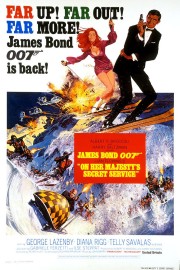On Her Majesty’s Secret Service
So, for my first “Golden Age” review for the James Bond series, I choose not one from the Connery era or the Moore era but…George Lazenby? Color me curious. Of course, I need to watch all of the 007 films at some point; though I’ve seen everything from “Goldeneye” on, the only pre-’90s movie I’ve seen until now is “Goldfinger.” Of course, you can always count on MGM to have a box set or two available to do just that. (And trust me, their Bond 50 set is on my list of “gets.”)
Why did I start with “On Her Majesty’s Secret Service,” then, the one and only film in the franchise to star Lazenby as Bond? I guess because it’s considered if not the best, certainly one of the most memorable. I’ll admit I’m still working on getting used to the style and pacing of the older films in the series, the let’s be honest, the character endures through even the lesser efforts.
One thing that “Goldfinger” and “On Her Majesty’s Secret Service” makes abundantly clear, however, is that music is indispensable to the series. There isn’t a title song like in most outings (although Louis Armstrong sings a love song, “We Have All the Time in the World,” by the time it’s over), but in both cases, the music by John Barry is a thing of beauty and excitement. In this film, Barry added synthesizers to the orchestral palette of Bond for the first time, and the way he uses it is lovely, and subtly imaginative. Unlike the hyperactive use of electronics in some of the most recent films (“Die Another Day,” in particular, stands out), Barry realizes that certain instruments and sounds are best used rarely, so as to enhance their effectiveness. Of course, the late composer, who was one of the franchise’s most prolific behind-the-scenes collaborators, was a master whose reputation was only enhanced by the Bond films, rather than defined by it. If you don’t believe me, check out his scores for films like “Body Heat” and “A Lion in Winter,” and of course, “Goldfinger.”
Back to Bond, though. The film is based on one of Ian Fleming’s novels in his spy series, which was written the same year the first film, “Dr. No,” went into production. Here, 007 is sent to Switzerland to investigate allergic testing being done by Blofeld (Telly Savalas), who had been the main villain in the previous two films, “Thunderball” and “You Only Live Twice.” This is the narrative that dominates the film from the second hour on, but the first hour finds Bond in unusual territory…love. Of course, he’s a master of the physical act, but the emotional area is another matter entirely, when he falls for the Contessa Teresa di Vicenzo (Diana Rigg), whom he saved in the film’s winking, but exciting, opening sequence. This is an idea we’d see explored later in the franchise, most notably in 2006’s Daniel Craig intro (also based on Fleming’s original material), but up to this point, this was new territory.
By the time the series hit film six with this movie, all of the pieces of the typical Bond adventure: the flirting with Moneypenny; the gadgets by Q (although this film had fewer than most); the tensions with M (Bernard Lee); the seduction of beautiful women; the elegant, but devious, villains; and of course, the action set pieces that typically defied the laws of nature. On that note, director Peter Hunt has some great ones, most famously, the extended sequence where Bond and Teresa are out-maneuvering bad guys skiing down the steep mountainside. Switzerland was an inspired location for the bulk of the action, and like any good location shoot, it adds a great deal of tension and excitement to the proceedings. Sure, the sequences can get a little silly (especially with some of the dated back projection), but this is one of the best Bond films in terms of story and adventure.
So, how did George Lazenby do? Well, it’s an understatement to say he’s no Sean Connery, whose natural charisma and sly wit fits the role like a glove. In comparison, Lazenby is a bit of a stick in the mud, although he does have a few good, genuinely affecting scenes, especially when it comes to Bond’s relationship with Teresa. That’s especially important for the end of the film, which is unexpected in its suddenness, and sadness. That said, Bond lives to fight another day, and after 43 more years, and 17 more films, audiences wouldn’t have it any other way.










